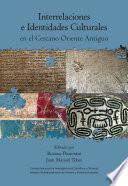Descargar Libro: Interrelaciones E Identidades Culturales En El Cercano Oriente Antiguo.

Autores
Resumen del Libro
More than 40 years after its birth, world-systems approximations and center-periphery approaches still provide an adequate framework for the analysis of political, economic and cultural interrelations of all kinds, both in the modern and the ancient world. Although the world-system theory was initially postulated to explain the emergence of capitalism in the modern world, later revisions clustered under the label of systems-world analysis incorporated the study of pre-modern societies, and especially of cultural interrelations and identities from them emerging. In this book, an interdisciplinary research group examines various case studies of ancient Near Eastern societies from Egypt and the Levant to Anatolia and Crete, from the 4th to the 1st millennia BCE, focusing on interregional relations at various scales and on how they affected the daily life of the peoples in them involved. The book contributes, on the one hand, to creatively respond to significant historical questions about the interrelationships and cultural identities that emerged at key moments in the history of the ancient Near East (When did they originate? What elements were transferred? How did they influence the contemporary communities? What are the particularities of such identities?), and on the other hand, to the much broader debate about the role played by the exchange in the development of social complexity in pre-modern societies.Articles by R. Flammini, J.M. Tebes, Philippe Beaujard, Amir Gorzalczany, Graciela Gestoso Singer, Romina Della Casa, and Jorge Cano Moreno.